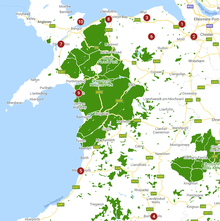Plantation (settlement or colony)
By the 1710s, the word was also being used to describe large farms where cash crop goods were produced, typically in tropical regions.
These plantations led to the demography of Ireland becoming permanently altered, creating a new Protestant Ascendancy which would dominate Irish society for the next few centuries.
[5] Most of these castles were built with an integrated fortified town, which was designed to be provisioned from safer territories and hold out against Welsh attacks, an idea that the Normans had developed from the bastides of Gascony.
[10][11][12][13][14] Beginning in the 1540's, the Tudor conquest of Ireland began, and roughly a decade later the first English plantations were established by British settlers on Irish soil.
[15][16] The next wave of plantations began during the reign of Queen Elizabeth I of England and were spearheaded by the West Country Men.
Elizabeth's policy in Ireland was to grant land to prospective planters and prevent the Irish from giving Spain a base from which to attack England.
England's efforts at colonization primarily focused on North America, where the first English plantation was established in 1607 at Jamestown.
[22] Upon arriving in Rhode Island, Williams and his followers received a land grant from two Narragansett sachems, Canonicus and Miantonomi.


